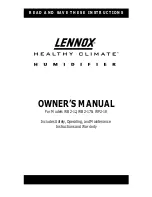
14
DTX10 - DTX80 USER GUIDE
9.
Maintenance Program
Daily
1. Check dew point or humidity level if instrumentation is available. Any difficulty with the dryer will result in
poor dewpoint performance.
2. Check for correct purge setting and air flow from purge exhaust.
3. Check gauge readings and sequence of operation through complete cycle.
4. Check auto drain operation on pre-filter, separator and receiver. A manual drain valve installed (in
addition to the automatic drain) at these points will ease checking of the automatic drains.
5. Ensure there is no back pressure in the regenerating tower.
Weekly
1. Check differential pressure across pre-filter and after-filter elements. Replace if required.
2. Check and maintain operating conditions; pressure, flow, and temperature within the design parameters
of the dryer.
Semi-Annually
1. Inspect desiccant for physical condition. Desiccant from a freshly regenerated bed should be white, dry
to touch and of consistent size and shape.
2. Check and clean mufflers. This may be required often under certain conditions or if back pressure
develops. Mufflers can be cleaned by blowing backwards through them with clean, dry air. Mufflers may
require replacement if severely clogged, or after a few cleanings.
3. Replace pre-filter and after-filter elements.
4. Clean automatic drain.
5. Replace control air filter element.
6. Check and slowdown safety valves. Refer to manufacturer’s instructions.
7. Clean dryer.
Annually
1. Inspect and rebuild inlet and exhaust valves.
2. Return DDS probe and chip for recalibration, if applicable.
9.1
Desiccant Replacement
CAUTION:
Activated Alumina Desiccant dust is considered a nuisance dust. Proper precautions
should be taken. Refer to “Material Safety Data Sheet”.
1.
Remove pressure and power from dryer.
2.
Open drain ports on bottom of tanks.















































